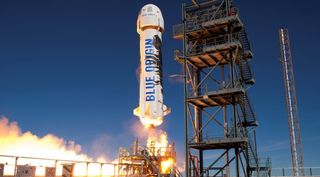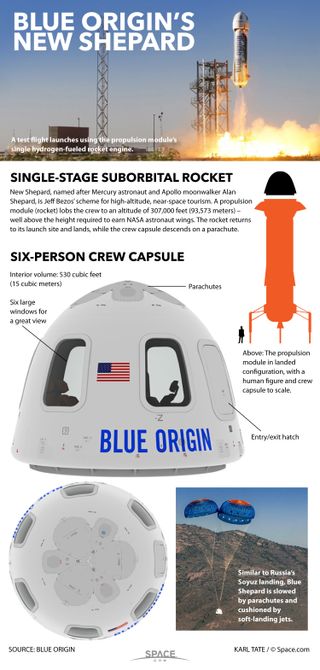Blue Origin Joins NASA's Suborbital Research Flight Program

BROOMFIELD, Colo. — NASA announced June 2 that it has awarded a contract to Blue Origin to perform suborbital research flights as part of the agency's Flight Opportunities program.
Under the indefinite-delivery, indefinite-quantity contract, Blue Origin will be eligible to fly research payloads on its New Shepard suborbital vehicle. The contract has a maximum value of $45 million, although the actual value depends on the number of task orders for research flights awarded by NASA.
Blue Origin, which has identified research payloads as one of the key markets for New Shepard, has already been working to attract customers on its own, signing up several "pathfinder" customers who will fly payloads on early test flights. Joining Flight Opportunities, company officials said, opens up another way for those customers to fly on the vehicle. [Photos: Glimpses of Secretive Blue Origin's Private Spaceships]

Under Flight Opportunities, individual researchers interested in flying on New Shepard can work directly with the company to submit a proposal for NASA to have that flight funded. Steve Jurczyk, NASA associate administrator for space technology, said at the conference that the program would separately broker flights for payloads developed or sponsored by NASA.
"We're really excited to have them on board and have this capability along with the other flight service providers," Jurczyk said in a speech at the conference announcing the Blue Origin contract.
In the near-term, Alexander said Flight Opportunities payloads would likely be included on the company's ongoing series of test flights of the vehicle. Those flights go to altitudes of 100 kilometers and provide three to four minutes of microgravity. Once in commercial service, Blue Origin expects to do dedicated research flights of New Shepard separate from flights carrying space tourists.
Blue Origin's most recent New Shepard test flight took place April 2. Alexander, speaking at the conference earlier in the day, said the next test flight of the vehicle would come "in the next short while," but declined to provide a more specific date. That upcoming test, he said, would differ from previous ones with a "more aggressive" tilt of the vehicle towards its landing pad, as well as disabling one of the three parachutes used to land the vehicle's crew capsule.
Get the Space.com Newsletter
Breaking space news, the latest updates on rocket launches, skywatching events and more!
Blue Origin is the sixth company to join the Flight Opportunities program, which has its origins in an initiative called the Commercial Reusable Suborbital Research Program, or CRuSR, announced at the NSRC in 2010. Three other companies — Masten Space Systems, UP Aerospace and Virgin Galactic — provide or plan to provide suborbital flights using rocket-powered vehicles. Near Space Corporation and World View Enterprises fly payloads on high-altitude balloons.
Despite a suborbital vehicle industry that has developed far more slowly than anticipated when the program began, NASA believes Flight Opportunities has been useful in supporting both researchers and vehicle providers. Jurczyk said the program has supported 46 flights of 172 different payloads to date. "Flight Opportunities, I think, has been a real success," he said.
While Blue Origin has plans to allow researchers to accompany their payloads on New Shepard flights, the Flight Opportunities program, for now, does not support the flights of human-tended payloads on suborbital vehicles. Then-NASA Deputy Administrator Lori Garver, speaking at the NSRC in 2013, said the program would allow funding of human-tended payloads in the future.
However, NASA has not followed through on that announcement. "To be honest with you, I do not have a strategy for how to move human-tended suborbital spaceflight forward," Jurczyk said. "However, I would welcome engagement with industry on both what's needed to move that forward, and what applications for NASA and commercial can be accomplished with that capability."
This story was provided by SpaceNews, dedicated to covering all aspects of the space industry.
Join our Space Forums to keep talking space on the latest missions, night sky and more! And if you have a news tip, correction or comment, let us know at: community@space.com.

Jeff Foust is a Senior Staff Writer at SpaceNews, a space industry news magazine and website, where he writes about space policy, commercial spaceflight and other aerospace industry topics. Jeff has a Ph.D. in planetary sciences from the Massachusetts Institute of Technology and earned a bachelor's degree in geophysics and planetary science from the California Institute of Technology. You can see Jeff's latest projects by following him on Twitter.

